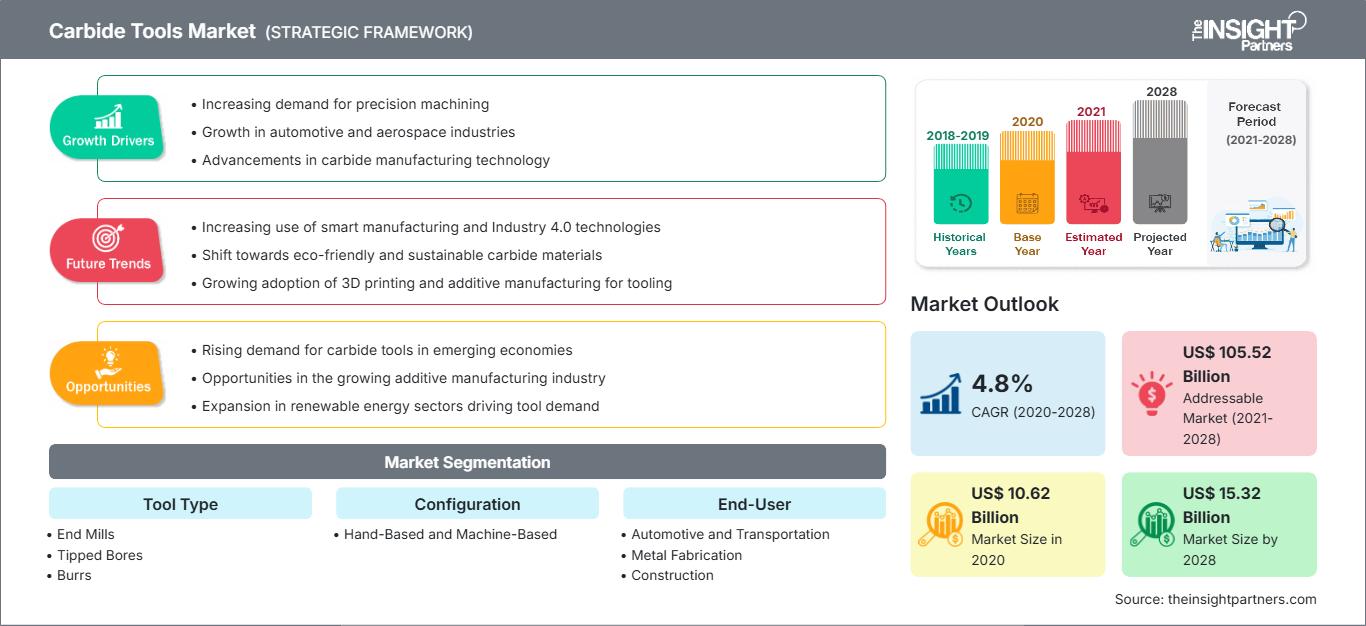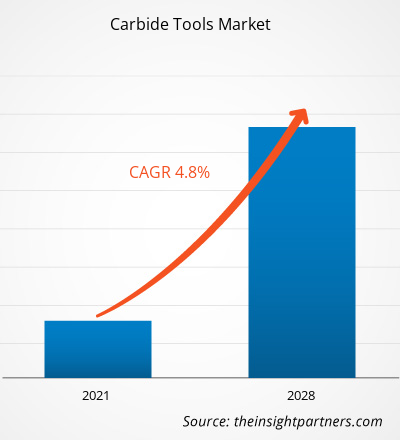[Forschungsbericht]Der Markt für Hartmetallwerkzeuge wurde im Jahr 2020 auf 10.623,97 Millionen US-Dollar geschätzt und soll bis 2028 15.320,99 Millionen US-Dollar erreichen; von 2021 bis 2028 wird ein CAGR-Wachstum von 4,8 % erwartet.
Steigende Entwicklungen in der Fertigungskonstruktion und wachsende Anforderungen zur Steigerung der Produktionseffizienz bilden die Grundlage für die Untersuchung hochwertiger Werkzeugmaschinenprodukte durch die Hersteller und steigern so die Nachfrage nach Hartmetallwerkzeugen. Die branchenübergreifend eingesetzten Werkzeugmaschinen werden hauptsächlich zum Bearbeiten oder Formen von Metall oder anderen starren Materialien verwendet, um mithilfe von Bohren, Schleifen, Scheren und Schneiden eine einzigartige Form zu erzielen. Derzeit gibt es zwei Haupttypen von Werkzeugmaschinen, die in verschiedenen Branchen stark im Einsatz sind: Schnellarbeitsstahl (HSS) und Hartmetallwerkzeuge. Diese Werkzeuge werden aufgrund ihrer herausragenden Eigenschaften wie hohe Geschwindigkeit, reduzierte Zykluszeit, lange Lebensdauer, Beibehaltung der Schneidkante bei hohen Bearbeitungstemperaturen und außergewöhnliche Verschleißfestigkeit der Schneidkante häufig in der Zerspanung eingesetzt. Die steigende Beliebtheit von Hartmetallwerkzeugen, insbesondere in der Fertigung, ist einer der wichtigsten Faktoren, die den Markt im Prognosezeitraum voraussichtlich ankurbeln werden. Darüber hinaus werden diese Hartmetallwerkzeuge in Fertigungseinheiten in der Automobil-, Luft- und Raumfahrt-, Eisenbahn-, Möbel- und Tischlerindustrie, Energie- und Stromindustrie sowie in der Gesundheitsgeräteindustrie eingesetzt. In diesen Branchen werden spezielle Schneidwerkzeuge zur Entwicklung und Herstellung eines Produkts verwendet, was die Nachfrage nach Hartmetallwerkzeugen ankurbelt. Der Einsatz von Hartmetallwerkzeugen in verschiedenen Branchen, ob manuell oder automatisch, fördert das Wachstum des Hartmetallwerkzeugmarktes weltweit weiter.
Passen Sie diesen Bericht Ihren Anforderungen an
Sie erhalten kostenlos Anpassungen an jedem Bericht, einschließlich Teilen dieses Berichts oder einer Analyse auf Länderebene, eines Excel-Datenpakets sowie tolle Angebote und Rabatte für Start-ups und Universitäten.
Markt für Hartmetallwerkzeuge: Strategische Einblicke

- Holen Sie sich die wichtigsten Markttrends aus diesem Bericht.Dieses KOSTENLOSE Beispiel umfasst Datenanalysen, die von Markttrends bis hin zu Schätzungen und Prognosen reichen.
Auswirkungen der COVID-19-Pandemie auf den Markt für Hartmetallwerkzeuge
Sie erhalten kostenlos Anpassungen an jedem Bericht, einschließlich Teilen dieses Berichts oder einer Analyse auf Länderebene, eines Excel-Datenpakets sowie tolle Angebote und Rabatte für Start-ups und Universitäten.
Markt für Hartmetallwerkzeuge: Strategische Einblicke

- Holen Sie sich die wichtigsten Markttrends aus diesem Bericht.Dieses KOSTENLOSE Beispiel umfasst Datenanalysen, die von Markttrends bis hin zu Schätzungen und Prognosen reichen.
Die COVID-19-Pandemie hat mehrere Branchen erschüttert. Die enorme Zunahme der Virusverbreitung hat Regierungen weltweit dazu veranlasst, strenge Beschränkungen für Fahrzeuge und die Bewegungsfreiheit von Menschen zu verhängen. Aufgrund von Reiseverboten, Massen-Lockdowns und Geschäftsschließungen hat die Pandemie die Volkswirtschaften und unzählige Industrien in verschiedenen Ländern negativ beeinflusst. Die Lockdowns führten zu einer geringeren Produktion von Rohstoffen, Gütern und Dienstleistungen. Daher verzeichneten die Fertigungsindustrie, die Automobilindustrie, die Halbleiter- und Elektronikindustrie, die Öl- und Gasindustrie, der Bergbau, die Luftfahrt und andere Branchen aufgrund der vorübergehenden Einstellung ihrer Aktivitäten einen Rückgang ihrer Geschäftstätigkeit.
Der weltweite Lockdown zur Minimierung der Virusübertragung hat die Lieferkettenaktivitäten sowie das Produktionsvolumen mehrerer Hersteller, insbesondere kleiner und mittlerer Unternehmen, erheblich gestört. Darüber hinaus sind die Produktionsaktivitäten in mehreren Branchen im Jahr 2020 deutlich zurückgegangen, was zu einem Rückgang des Marktes für Hartmetallwerkzeuge führte. Mit dem steigenden Bedarf an Gesundheitsprodukten steigt jedoch auch die Nachfrage nach Hartmetallwerkzeugen in der Medizinbranche.
Markteinblicke zu Hartmetallwerkzeugen: Produktionssteigerung im Automobilsektor treibt Wachstum des Marktes für Hartmetallwerkzeuge an
Die Automobilproduktion steigt weltweit, insbesondere in asiatischen und europäischen Ländern, stetig an, was die Nachfrage nach Hartmetallwerkzeugen antreibt. Der Sektor verwendet Hartmetallwerkzeuge häufig zur Kurbelwellenbearbeitung, zum Planfräsen und Bohren sowie für andere Bearbeitungsvorgänge in der Autoteileherstellung. Die Automobilindustrie erzielt hervorragende Ergebnisse mit der Verwendung von Wolframkarbid in Kugelgelenken, Bremsen, Kurbelwellen von Hochleistungsfahrzeugen und anderen mechanischen Fahrzeugteilen, die starker Beanspruchung und extremen Temperaturen ausgesetzt sind. Automobilgiganten wie Audi, BMW, Ford Motor Company und Range Rover tragen erheblich zum Wachstum des Marktes für Hartmetallwerkzeuge bei. Hybridfahrzeuge gewinnen in Nordamerika an Bedeutung und kurbeln so das Marktwachstum für Hartmetallwerkzeuge in der Region an. Länder wie die USA und Kanada sind bedeutende Automobilhersteller in der Region. Laut dem American Automotive Policy Council tragen Automobilhersteller und ihre Zulieferer etwa 3 % zum US-BIP bei. General Motors Company, Ford Motor Company, Fiat Chrysler Automobiles und Daimler gehören zu den größten Automobilherstellern in Nordamerika. Laut Daten der Internationalen Organisation der Kraftfahrzeughersteller (IOM) produzierten die USA und Kanada im Jahr 2019 etwa 2.512.780 bzw. 461.370 Autos. Darüber hinaus werden Hartmetallwerkzeuge auch häufig in der Eisenbahn-, Luft- und Raumfahrt-, Verteidigungs- und Schifffahrtsindustrie eingesetzt.
Markteinblicke nach Werkzeugtyp
Basierend auf dem Werkzeugtyp ist der Markt für Hartmetallwerkzeuge in Schaftfräser, Bohrer mit Spitze, Fräser, Bohrer, Fräser und andere Werkzeuge unterteilt. Im Jahr 2020 hatte das Segment Schaftfräser den größten Marktanteil.
Konfigurationsbasierte Markteinblicke
Basierend auf der Konfiguration ist der Markt für Hartmetallwerkzeuge in handbasierte und maschinenbasierte Werkzeuge unterteilt. Im Jahr 2020 hatte das maschinenbasierte Segment einen größeren Marktanteil.
Endbenutzerbasierte Markteinblicke
Nach Endbenutzern ist der Markt für Hartmetallwerkzeuge in die Bereiche Automobil und Transport, Metallverarbeitung, Bauwesen, Öl und Gas, Schwermaschinen und andere Endbenutzer unterteilt. Im Jahr 2020 hatte das Segment Automobil und Transport den größten Marktanteil.
Die auf dem Markt für Hartmetallwerkzeuge tätigen Akteure verfolgen Strategien wie Fusionen, Übernahmen und Marktinitiativen, um ihre Position auf dem Markt zu behaupten. Nachfolgend sind einige Entwicklungen wichtiger Akteure aufgeführt:
- Im November 2020 ging GARR TOOL eine Partnerschaft mit Mastercam ein, um Kunden eine komplette Werkzeugbibliothek nativ innerhalb der Mastercam-Plattform anzubieten. Die Partnerschaft wird für aktuelle und zukünftige Kunden von enormem Wert sein, da der Fertigungsprozess immer mehr auf einen sofortigen und einfachen Datenzugriff angewiesen ist.
- Im Februar 2019 erwarb die CERATIZIT-Gruppe 50 % der Anteile an der Stadler Metalle GmbH & Co. KG. Das Unternehmen gab an, dass die Investition in Stadler es ihm ermöglicht habe, die gesamte Rohstoffversorgungskette zu sichern und sich bei der Rohstoffversorgung noch stärker auf das Recycling von Hartmetallwerkzeugen zu konzentrieren.
Markt für Hartmetallwerkzeuge
Die Analysten von The Insight Partners haben die regionalen Trends und Faktoren, die den Markt für Hartmetallwerkzeuge im Prognosezeitraum beeinflussen, ausführlich erläutert. In diesem Abschnitt werden auch die Marktsegmente und die geografische Lage in Nordamerika, Europa, dem asiatisch-pazifischen Raum, dem Nahen Osten und Afrika sowie Süd- und Mittelamerika erörtert.Umfang des Marktberichts zu Hartmetallwerkzeugen
| Berichtsattribut | Einzelheiten |
|---|---|
| Marktgröße in 2020 | US$ 10.62 Billion |
| Marktgröße nach 2028 | US$ 15.32 Billion |
| Globale CAGR (2020 - 2028) | 4.8% |
| Historische Daten | 2018-2019 |
| Prognosezeitraum | 2021-2028 |
| Abgedeckte Segmente |
By Werkzeugtyp
|
| Abgedeckte Regionen und Länder | Nordamerika
|
| Marktführer und wichtige Unternehmensprofile |
|
Dichte der Marktteilnehmer für Hartmetallwerkzeuge: Verständnis ihrer Auswirkungen auf die Geschäftsdynamik
Der Markt für Hartmetallwerkzeuge wächst rasant. Dies wird durch die steigende Endverbrauchernachfrage aufgrund veränderter Verbraucherpräferenzen, technologischer Fortschritte und eines stärkeren Bewusstseins für die Produktvorteile vorangetrieben. Mit der steigenden Nachfrage erweitern Unternehmen ihr Angebot, entwickeln Innovationen, um den Bedürfnissen der Verbraucher gerecht zu werden, und nutzen neue Trends, was das Marktwachstum weiter ankurbelt.

- Holen Sie sich die Markt für Hartmetallwerkzeuge Übersicht der wichtigsten Akteure
- Schaftfräser
- Bestückte Bohrer
- Frässtifte
- Bohrer
- Fräser
- Andere Werkzeuge
Nach Konfiguration
- Handgeführt
- Maschinengeführt
Nach Endbenutzer
- Automobil und Transport
- Metallverarbeitung
- Bauwesen
- Öl und Gas
- Schwermaschinen
- Andere Endbenutzer
Nach Geografie
- Nord Amerika
- USA
- Kanada
- Mexiko
Europa - Frankreich Korea
- Japan
- Australien
- Rest von APAC
- Naher Osten und Asien Afrika (MEA)
- Südafrika
- Saudi-Arabien
- VAE
- Rest von MEA
- Südamerika (SAM)
- Brasilien
- Argentinien
- Rest von SAM
Firmenprofile
- Xinrui Industry Co., Ltd.
- CERATIZIT SA
- GARR TOOL
- Ingersoll Cutting Tool Company
- KYOCERA Precision Tools
- DIMAR GROUP
- MITSUBISHI MATERIALS Corporation
- Sandvik Coromant
- YG-1 Co., Ltd.
- Makita Corporation
- Historische Analyse (2 Jahre), Basisjahr, Prognose (7 Jahre) mit CAGR
- PEST- und SWOT-Analyse
- Marktgröße Wert/Volumen – Global, Regional, Land
- Branchen- und Wettbewerbslandschaft
- Excel-Datensatz
Aktuelle Berichte
Erfahrungsberichte
Grund zum Kauf
- Fundierte Entscheidungsfindung
- Marktdynamik verstehen
- Wettbewerbsanalyse
- Kundeneinblicke
- Marktprognosen
- Risikominimierung
- Strategische Planung
- Investitionsbegründung
- Identifizierung neuer Märkte
- Verbesserung von Marketingstrategien
- Steigerung der Betriebseffizienz
- Anpassung an regulatorische Trends




















 Kostenlose Probe anfordern für - Markt für Hartmetallwerkzeuge
Kostenlose Probe anfordern für - Markt für Hartmetallwerkzeuge